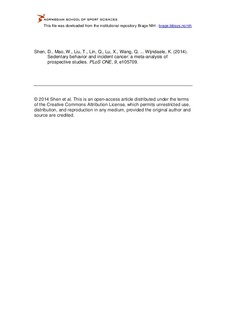| dc.description.abstract | Sedentary behavior is ubiquitous in modern adults' daily lives and it has been suggested to be associated with incident cancer. However, the results have been inconsistent. In this study, we performed a systematic review and meta-analysis of prospective cohort studies to clarify the association between sedentary behavior and incident cancer.
Method: PubMed and Embase databases were searched up to March 2014. All prospective cohort studies on the association between sedentary behavior and incident cancer were included. The summary relative risks (RRs) with 95% confidence intervals (CIs) were estimated using random effect model.
Results: A total of 17 prospective studies from 14 articles, including a total of 857,581 participants and 18,553 cases, were included in the analysis for sedentary behavior and risk of incident cancer. The overall meta-analysis suggested that sedentary behavior increased risk of cancer (RR = 1.20, 95%CI = 1.12–1.28), with no evidence of heterogeneity between studies (I2 = 7.3%, P = 0.368). Subgroup analyses demonstrated that there were statistical associations between sedentary behavior and some cancer types (endometrial cancer: RR = 1.28, 95% CI = 1.08–1.53; colorectal cancer: RR = 1.30, 95%CI = 1.12–1.49; breast cancer: RR = 1.17, 95%CI = 1.03–1.33; lung cancer: RR = 1.27, 95%CI = 1.06–1.52). However, there was no association of sedentary behavior with ovarian cancer (RR = 1.26, 95%CI = 0.87–1.82), renal cell carcinoma (RR = 1.11, 95%CI = 0.87–1.41) or non-Hodgkin lymphoid neoplasms (RR = 1.09, 95%CI = 0.82–1.43).
Conclusion: The present meta-analysis suggested that prolonged sedentary behavior was independently associated with an increased risk of incident endometrial, colorectal, breast, and lung cancers, but not with ovarian cancer, renal cell carcinoma or non-Hodgkin lymphoid neoplasms. | nb_NO |
